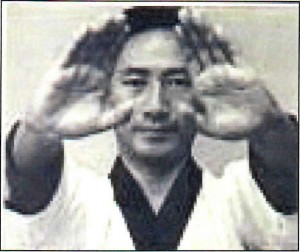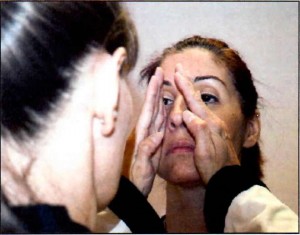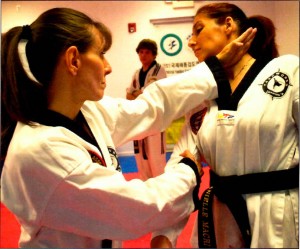The hand position that is the beginning of Koryo poomse is described in many ways, ranging from a Chi Kung energy concentration to the more fanciful “gazing at the sun”. In this discussion I would like to propose an alternate interpretation of this movement, and the subsequent knife hand block.
For those unfamiliar with the form: both hands rise from stomach area, close to the body, to face level. They are then pushed forward with the side of the hands straight out. A knife hand blocking movement to the left follows this.
Our targets for this initial strike lie on the Stomach meridian. Specifically, St. 1,2,3. These points lie on the face in a straight line dropped from the pupils of the eye to the level of the bottom of the nose.
These points are symmetrical and will be found on both sides of the face.
We will be striking with the outside edges of the hands—Knife hand edge.
Of course this can be struck with only one hand, but since hitting on both sides of the body always has a more amplified effect, we will demonstrate it as the form does.
The key to success in this is to not allow the opponent to see the attack coming. If you just stick your hands in their face, they will simply block them. You have to raise your hands below their line of sight. This can be done by holding them close to your body, as the form does, or close to theirs.
The goal of the strike is to knock their head back and disorient them. Once this is done we move the next part.
Instead of viewing this as the so called “knife hand block”. Let us instead view it as a continuation of the prior defensive movements.
In this scenario (above), we have just preempted an attack, and in the brief interval created, we reach out to their opposite arm (in this case our right to their right), and with our other hand hit the opposite side of the neck.
By shifting to a back stance and continuing the knife hand block movement exactly as it is done in the form, the opponent will thrown to the ground. Of course, as the form is symmetrical, the technique works to either side.
CAUTIONARY NOTE: while these techniques are paired together, as they are in the form, either of them, taken alone, isperfectly capable of effecting a knockout, or causing serious injury. Please use only very light pressure when practicing.
Here is a video of the technique:
Richard would like to thank Master Mike Barnard and his instructors D. Macri, D. Post, and H. Stehlik of Han Ho Martial Arts for their kind participation. Also Bob Adams of RADesigns for the photography
*top image R. Chun “TKD Spirit and Practice” YMAA publications copyright 2002




